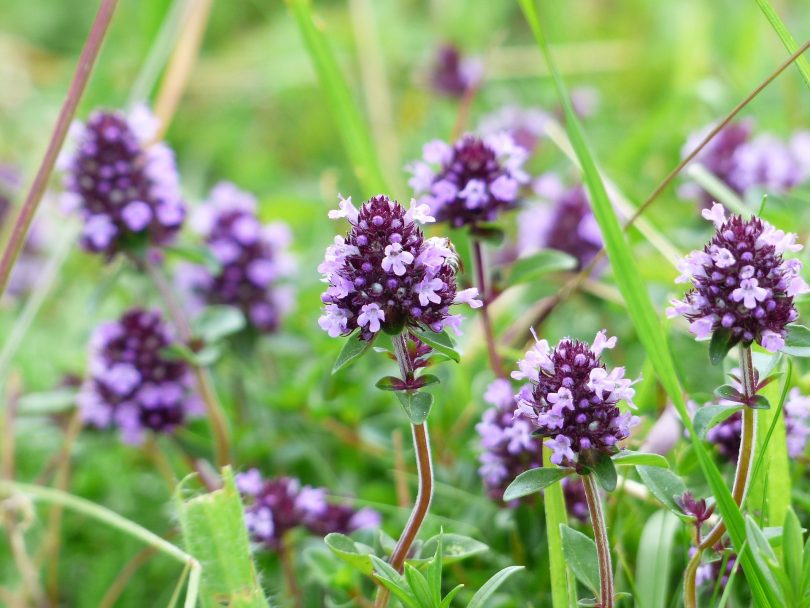While not a cannabis household name, being that it’s a secondary monoterpene usually present in low concentrations in cannabis, cymene is actually a very common terpene found in more than 100 plants and 200 foods [1], many of which are highly popular. This is good news, as the terpene seems to have a myriad of potential health benefits.
p-Cymene.
NEUROtiker – Public Domain.
Cymene in Plants and Foods
Some of cymene’s most popular “appearances” include staples like oregano, eucalyptus, cilantro, thyme, cumin, coriander, and many more. [1] The terpene is also used as a flavoring agent in meats and other foods. Para-cymene, or p-cymene, is the common naturally-occurring form.
The odor of cymene has been described as soft and pleasant with woody, spicy, and citrus tones. [1]
Medicinal Properties
Antibacterial
Thyme oil is actually a common constituent of cleaning detergents; cymene is a key component of this oil [2].
Furthermore, cymene, in combination with carvacrol, a monoterpenoid phenol, was found to inactivate E.coli in apple juice [3], which could imply a synergetic relationship that is in line with the idea of the entourage effect.
Anti-Inflammatory and Analgesic
Cymene has demonstrated anti-inflammatory and analgesic properties in two separate studies on mice. In the first one, the terpene proved to slow down the onset of pain [4], and in the latter, the mechanism behind these properties was traced back to cymene’s activity on the opioid system and inflammatory cytokines [5]. This is in line with another study’s findings, which revealed cymene modulates in vitro and in vivo cytokine production; as pain reduction was “mediated by the activation of opioid receptors,” the authors suggested “involvement of descending pain-inhibitory mechanisms.” [6]
Antioxidant and Neuroprotective
Cymene has also been described as a natural antioxidant by Brazilian scientists [7], and as such, it has also been found to exhibit neuroprotective properties by reducing oxidative stress in brain cells [8].
Anti-Cancer
Cymene has been combined with metallic agents (e.g., osmium or ruthenium) to form complexes explored as an anti-cancer agents on laboratory-produced human cells. Organometallic cymene managed to induce cell death via apoptosis in ovarian cancer [9] and lung cancer [10], giving scientists a reason to believe in its anti-cancer potential and interest in future research.
With extraction innovations and our understanding of cannabis constantly advancing, generally low levels of cymene in cannabis can likely be overcome, opening avenues for cannabinoid and terpene mixology and optimal synergetic therapeutic benefits.
Image: Flowering thyme; Hans Braxmeier from Pixabay
References:
- Marchese A, et al. Update on monoterpenes as antimicrobial agents: A particular focus on p-cymene. Materials (Basel). 2017;10:947. doi:10.3390/ma10080947. Journal Impact Factor = 3.057; Times Cited = 39
- García CR, et al. Antimicrobial activity and chemical composition of Thymus vulgaris, Thymus zygisand Thymus hyemalis essential oils. Food Control. 2008;19(7):681-687. Journal Impact Factor = 4.258; Times Cited = 466
- Kiskó G, Roller S. Carvacrol and p-cymene inactivate Escherichia coli O157:H7 in apple juice. BMC Microbiol. 2005;5(1):36. Journal Impact Factor = 2.989; Times Cited = 125
- Bonjardim L, et al. Evaluation of the anti-inflammatory and antinociceptive properties of p-cymene in mice. Zeitschrift für Naturforschung C: A Journal of Biosciences. 2012;67(1-2):15-21. Journal Impact Factor = 1.238; Times Cited = 42
- de Santana MF, et al. The anti-hyperalgesic and anti-inflammatory profiles of p-cymene: Evidence for the involvement of opioid system and cytokines. Pharm Biol. 2015;53(11):1583-90. Journal Impact Factor = 2.971; Times Cited = 24
- Weiting Z, et al. p-Cymene modulates in vitro and in vivo cytokine production by inhibiting MAPK and NF-κB activation. Inflammation.2013;36(3):529-37. Journal Impact Factor = 4.953; Times Cited = 32
- de Oliveira TM, et al. Evaluation of p-cymene, a natural antioxidant. Pharm Biol. 2014;53(3):423-8. Journal Impact Factor = 1.241; Times Cited = 43
- Liu Y, et al. Aromatic monoterpenoid glycosides from rattan stems of Schisandra chinensis and their neuroprotective activities. Fitoterapia. 2019;134:108-112. Journal Impact Factor = 2.527; Times Cited = 1
- Păunescu E, et al. Anticancer organometallic osmium(II)-p-cymene complexes. ChemMedChem. 2015;10(9):1539-47. Journal Impact Factor = 3.124; Times Cited = 14
- Bhatti MZ, et al. Anticancer activity and mechanism of bis-pyrimidine based dimetallic Ru(II)(η 6-p-cymene) complex in human non-small cell lung cancer via p53-dependent pathway. J Inorg Biochem. 2019;194:52-64, Journal Impact Factor = 3.212; Times Cited = 3









